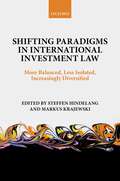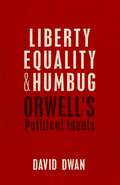- Table View
- List View
Defensive Killing: An Essay On War And Self-defence
by Helen FroweMost people believe that it is sometimes morally permissible for a person to use force to defend herself or others against harm. In Defensive Killing, Helen Frowe offers a detailed exploration of when and why the use of such force is permissible. She begins by considering the use of force between individuals, investigating both the circumstances under which an attacker forfeits her right not to be harmed, and the distinct question of when it is all-things-considered permissible to use force against an attacker. Frowe then extends this enquiry to war, defending the view that we should judge the ethics of killing in war by the moral rules that govern killing between individuals. She argues that this requires us to significantly revise our understanding of the moral status of non-combatants in war. Non-combatants who intentionally contribute to an unjust war forfeit their rights not to be harmed, such that they are morally liable to attack by combatants fighting a just war.
Mobilizing Knowledge in Healthcare: Challenges for Management and Organization
The research-practice gap is a persistent problem in healthcare - significant new knowledge is created but only some of it is shared and even less is used. As a consequence, many innovative ideas fail to change practice in healthcare settings. Academics, practitioners, and governments alike, agree that finding new ways of mobilizing knowledge is critical to reducing this gap. Yet knowledge mobilization is especially difficult in such a complex setting. This is because knowledge is essentially social and contextual in its very nature. Straightforward, linear 'transfer' models fail to work. This book provides an alternative 'knowledge mobilization' view, that examines in detail how knowledge is circulated and negotiated among those involved in healthcare, and how it is used to actually transform practice. Building on the collective scholarship of some of the most prominent academics in this area, the chapters explore the dynamics of knowledge mobilization, focusing on the challenges these pose for organization and management and how these challenges can be overcome.
The Oxford Companion to Shakespeare
by Michael Dobson Stanley Wells Will Sharpe Erin SullivanThe Oxford Companion to Shakespeare is the most comprehensive reference work available on Shakespeare's life, times, works, and his 400-year global legacy. In addition to the authoritative A-Z entries, it includes nearly 100 illustrations, a chronology, a guide to further reading, a thematic contents list, and special feature entries on each of Shakespeare's works. Tying in with the 400th anniversary of Shakespeare's death, this much-loved Companion has been revised and updated, reflecting developments and discoveries made in recent years and to cover the performance, interpretation, and the influence of Shakespeare's works up to the present day. First published in 2001, the online edition was revised in 2011, with updates to over 200 entries plus 16 new entries. These online updates appear in print for the first time in this second edition, along with a further 35,000 new and revised words. These include more than 80 new entries, ranging from important performers, directors, and scholars (such as Lucy Bailey, Samuel West, and Alfredo Michel Modenessi), to topics as diverse as Shakespeare in the digital age and the ubiquity of plants in Shakespeare's works, to the interpretation of Shakespeare globally, from Finland to Iraq. To make information on Shakespeare's major works easier to find, the feature entries have been grouped and placed in a centre section (fully cross-referenced from the A-Z). The thematic listing of entries - described in the press as 'an invaluable panorama of the contents' - has been updated to include all of the new entries. This edition contains a preface written by much-lauded Shakespearian actor Simon Russell Beale. Full of both entertaining trivia and scholarly detail, this authoritative Companion will delight the browser and reward students, academics, as well as anyone wanting to know more about Shakespeare.
Italy 1636: Cemetery of Armies
by Gregory HanlonItaly 1636 is one of the most closely-researched and detailed books on the operation of early modern armies anywhere, and is explicitly inspired by neo-Darwinian thinking. Taking the French and Savoyard invasion of Spanish Lombardy in 1636 as its specific example, it begins with the recruitment of the soldiers, the care and feeding of the armies and their horses, the impact of the invasion on civilians in the path of their advance, and the manner in which generals conducted their campaign in response to the information at their disposal. The next section describes the unfolding of the long and stubborn battle of Tornavento, where Spanish, German, and Italian soldiers stormed the French in their entrenchments, detailing the tactics of both the infantry and the cavalry, and re-evaluating the effectiveness of Spanish methods in the 1630s. The account focuses on the motivations of soldiers to fight, and how they reacted to the stress of combat. Gregory Hanlon arrives at surprising conclusions on the conditions under which they were ready to kill their adversaries, and when they were content to intimidate them into retiring. The volume concludes by examining the penchant for looting of the soldiery in the aftermath of battle, the methods of treating wounded soldiers in the Milan hospital, the horrific consequences of hygienic breakdown in the French camp, and the strategic failure of the invasion in the aftermath of battle. This in turn underscores the surprising resilience of Spanish policies and Spanish arms in Europe. In describing with painstaking detail the invasion of 1636, Hanlon explores the universal features of human behaviour and psychology as they relate to violence and war.
Essentials of Dental Caries
by Edwina Kidd Ole FejerskovDental caries (tooth decay) is one of the most highly prevalent diseases around the world affecting a significant proportion of the population. Dental caries may take place on any tooth surface in the oral cavity where dental plaque is allowed to develop over a period of time. Understanding its causes and progression allows the dental team to help the patient control and manage it so that patients can maintain healthy teeth for life. The fourth edition of Essentials of Dental Caries provides readers with an up-to-date, clinically relevant guide to dental caries. Written in an accessible style, the authors explain the biological and socioeconomic background of lesion development and progress. Current methods of clinical diagnosis and evidence based management are outlined in clearly laid out and highly illustrated chapters. This book is essential reading for students and practitioners of dentistry, dental therapy, dental hygiene, and oral health educators.
Essentials of Dental Caries
by Edwina Kidd Ole FejerskovDental caries (tooth decay) is one of the most highly prevalent diseases around the world affecting a significant proportion of the population. Dental caries may take place on any tooth surface in the oral cavity where dental plaque is allowed to develop over a period of time. Understanding its causes and progression allows the dental team to help the patient control and manage it so that patients can maintain healthy teeth for life. The fourth edition of Essentials of Dental Caries provides readers with an up-to-date, clinically relevant guide to dental caries. Written in an accessible style, the authors explain the biological and socioeconomic background of lesion development and progress. Current methods of clinical diagnosis and evidence based management are outlined in clearly laid out and highly illustrated chapters. This book is essential reading for students and practitioners of dentistry, dental therapy, dental hygiene, and oral health educators.
Oxford Handbook of Geriatric Medicine (Oxford Medical Handbooks)
by Lesley K. Bowker James D. Price Kunal S. Shah Sarah C. SmithThis new edition of the Oxford Handbook in Geriatric Medicine has been expanded and updated to reflect the substantial changes in clinical practice since the previous edition, including the Francis report and the impact on care for the older patient, the National Dementia Strategy and screening, and the evolution of the role of Geriatricians in other specialities. It includes new material on risk scoring management of TIA, and a new chapter on the older surgical patient. With an ageing population, geriatric medicine is increasingly central to emergency and internal medicine in hospital settings and in general practice. Diseases are more common in the older person, and can be particularly difficult to assess and to treat effectively in a field that has limited evidence, yet makes up a substantial proportion of the work of most clinicians. Using clinical vignettes and how-to boxes to provide practical advice on common problems, this is a practical, accessible, and essential handbook for all medical staff who manage older patients.
Oxford Handbook of Geriatric Medicine (Oxford Medical Handbooks)
by Lesley K. Bowker James D. Price Kunal S. Shah Sarah C. SmithThis new edition of the Oxford Handbook in Geriatric Medicine has been expanded and updated to reflect the substantial changes in clinical practice since the previous edition, including the Francis report and the impact on care for the older patient, the National Dementia Strategy and screening, and the evolution of the role of Geriatricians in other specialities. It includes new material on risk scoring management of TIA, and a new chapter on the older surgical patient. With an ageing population, geriatric medicine is increasingly central to emergency and internal medicine in hospital settings and in general practice. Diseases are more common in the older person, and can be particularly difficult to assess and to treat effectively in a field that has limited evidence, yet makes up a substantial proportion of the work of most clinicians. Using clinical vignettes and how-to boxes to provide practical advice on common problems, this is a practical, accessible, and essential handbook for all medical staff who manage older patients.
Stroke Medicine (Oxford Specialist Handbooks in Neurology)
by Hugh Markus Anthony Pereira Geoffrey CloudThe second edition of Stroke Medicine incorporates considerable advances in the treatment of stroke that have occurred since the first edition published. This provides an up-to-date and easily accessible source of information on all aspects of stroke care, from acute care through to rehabilitation and secondary prevention. The new edition includes some additional updates on cardiac investigation of stroke, due to novel methods for detecting atrial fibrillation, and new trial data has been added to the chapter on Treatment of Stroke. The book includes numerous illustrations and tables presenting information in an easy-to-follow way and is designed to be used by the practising physician as a practical handbook of stroke care.
Stroke Medicine (Oxford Specialist Handbooks in Neurology)
by Anthony Pereira Hugh Markus Geoffrey CloudThe second edition of Stroke Medicine incorporates considerable advances in the treatment of stroke that have occurred since the first edition published. This provides an up-to-date and easily accessible source of information on all aspects of stroke care, from acute care through to rehabilitation and secondary prevention. The new edition includes some additional updates on cardiac investigation of stroke, due to novel methods for detecting atrial fibrillation, and new trial data has been added to the chapter on Treatment of Stroke. The book includes numerous illustrations and tables presenting information in an easy-to-follow way and is designed to be used by the practising physician as a practical handbook of stroke care.
The Enlightenment that Failed: Ideas, Revolution, and Democratic Defeat, 1748-1830
by Jonathan I. IsraelThe Enlightenment that Failed explores the growing rift between those Enlightenment trends and initiatives that appealed exclusively to elites and those aspiring to enlighten all of society by raising mankind's awareness, freedoms, and educational level generally. Jonathan I. Israel explains why the democratic and radical secularizing tendency of the Western Enlightenment, after gaining some notable successes during the revolutionary era (1775-1820) in numerous countries, especially in Europe, North America, and Spanish America, ultimately failed. He argues that a populist, Robespierriste tendency, sharply at odds with democratic values and freedom of expression, gained an ideological advantage in France, and that the negative reaction this generally provoked caused a more general anti-Enlightenment reaction, a surging anti-intellectualism combined with forms of religious revival that largely undermined the longings of the deprived, underprivileged, and disadvantaged, and ended by helping, albeit often unwittingly, conservative anti-Enlightenment ideologies to dominate the scene. The Enlightenment that Failed relates both the American and the French revolutions to the Enlightenment in a markedly different fashion from how this is usually done, showing how both great revolutions were fundamentally split between bitterly opposed and utterly incompatible ideological tendencies. Radical Enlightenment, which had been an effective ideological challenge to the prevailing monarchical-aristocratic status quo, was weakened, then almost entirely derailed and displaced from the Western consciousness, in the 1830s and 1840s by the rise of Marxism and other forms of socialism.
The Enlightenment that Failed: Ideas, Revolution, and Democratic Defeat, 1748-1830
by Jonathan I. IsraelThe Enlightenment that Failed explores the growing rift between those Enlightenment trends and initiatives that appealed exclusively to elites and those aspiring to enlighten all of society by raising mankind's awareness, freedoms, and educational level generally. Jonathan I. Israel explains why the democratic and radical secularizing tendency of the Western Enlightenment, after gaining some notable successes during the revolutionary era (1775-1820) in numerous countries, especially in Europe, North America, and Spanish America, ultimately failed. He argues that a populist, Robespierriste tendency, sharply at odds with democratic values and freedom of expression, gained an ideological advantage in France, and that the negative reaction this generally provoked caused a more general anti-Enlightenment reaction, a surging anti-intellectualism combined with forms of religious revival that largely undermined the longings of the deprived, underprivileged, and disadvantaged, and ended by helping, albeit often unwittingly, conservative anti-Enlightenment ideologies to dominate the scene. The Enlightenment that Failed relates both the American and the French revolutions to the Enlightenment in a markedly different fashion from how this is usually done, showing how both great revolutions were fundamentally split between bitterly opposed and utterly incompatible ideological tendencies. Radical Enlightenment, which had been an effective ideological challenge to the prevailing monarchical-aristocratic status quo, was weakened, then almost entirely derailed and displaced from the Western consciousness, in the 1830s and 1840s by the rise of Marxism and other forms of socialism.
Shifting Paradigms in International Investment Law: More Balanced, Less Isolated, Increasingly Diversified
International investment law is in transition. Whereas the prevailing mindset has always been the protection of the economic interests of individual investors, new developments in international investment law have brought about a paradigm shift. There is now more than ever before an interest in a more inclusive, transparent, and public regime. Shifting Paradigms in International Investment Law addresses these changes against the background of the UNCTAD framework to reform investment treaties. The book analyses how the investment treaty regime has changed and how it ought to be changing to reconcile private property interests and the state's duty to regulate in the public interest. In doing so, the volume tracks attempts in international investment law to recalibrate itself towards a more balanced, less isolated, and increasingly diversified regime. The individual chapters of this edited volume address the contents of investment agreements, the system of dispute settlement, the interrelation of investment agreements with other areas of public international law, constitutional questions, and new regional perspectives from Europe, South Africa, the Pacific Rim Region, and Latin America. Together they provide an invaluable resource for scholars, practitioners, and policymakers. The individual chapters of this edited volume address the contents of investment agreements, the system of dispute settlement, the interrelation of investment agreements with other areas of public international law, constitutional questions, and new regional perspectives from Europe, South Africa, the Pacific Rim Region, and Latin America. Together they provide an invaluable resource for scholars, practitioners, and policymakers.
Shifting Paradigms in International Investment Law: More Balanced, Less Isolated, Increasingly Diversified
by Steffen Hindelang and Markus KrajewskiInternational investment law is in transition. Whereas the prevailing mindset has always been the protection of the economic interests of individual investors, new developments in international investment law have brought about a paradigm shift. There is now more than ever before an interest in a more inclusive, transparent, and public regime. Shifting Paradigms in International Investment Law addresses these changes against the background of the UNCTAD framework to reform investment treaties. The book analyses how the investment treaty regime has changed and how it ought to be changing to reconcile private property interests and the state's duty to regulate in the public interest. In doing so, the volume tracks attempts in international investment law to recalibrate itself towards a more balanced, less isolated, and increasingly diversified regime. The individual chapters of this edited volume address the contents of investment agreements, the system of dispute settlement, the interrelation of investment agreements with other areas of public international law, constitutional questions, and new regional perspectives from Europe, South Africa, the Pacific Rim Region, and Latin America. Together they provide an invaluable resource for scholars, practitioners, and policymakers. The individual chapters of this edited volume address the contents of investment agreements, the system of dispute settlement, the interrelation of investment agreements with other areas of public international law, constitutional questions, and new regional perspectives from Europe, South Africa, the Pacific Rim Region, and Latin America. Together they provide an invaluable resource for scholars, practitioners, and policymakers.
The Oxford Handbook of the Australian Constitution (Oxford Handbooks)
Constitutional law provides the legal framework for the Australian political and legal systems, and thus touches almost every aspect of Australian life. The Handbook offers a critical analysis of some of the most significant aspects of Australian constitutional arrangements, setting them against the historical, legal, political, and social contexts in which Australia's constitutional system has developed. It takes care to highlight the distinctive features of the Australian constitutional system by placing the Australian system, where possible, in global perspective. The chapters of the Handbook are arranged in seven thematically-grouped parts. The first, 'Foundations', deals with aspects of Australian history which have influenced constitutional arrangements. The second, 'Constitutional Domain', addresses the interaction between the constitution and other relevant legal systems and orders, including the common law, international law, and state constitutions. The third, 'Themes', identifies themes of special constitutional significance, including the legitimacy of the constitution, citizenship, and republicanism. The fourth, 'Practice and Process', deals with practical issues relevant to constitutional litigation, including the processes, techniques, and authority of the High Court of Australia. The final three parts deal with the structural building blocks of the Australian Constitutional system: 'Separation of Powers', 'Federalism', and the 'Protection of Rights.' Written by a team of experts drawn from academia and practice, the Handbook provides Australian and international readers alike with a reliable source of knowledge, understanding, and insight into the Australian Constitution.
The Oxford Handbook of the Australian Constitution (Oxford Handbooks)
by Cheryl Saunders and Adrienne StoneConstitutional law provides the legal framework for the Australian political and legal systems, and thus touches almost every aspect of Australian life. The Handbook offers a critical analysis of some of the most significant aspects of Australian constitutional arrangements, setting them against the historical, legal, political, and social contexts in which Australia's constitutional system has developed. It takes care to highlight the distinctive features of the Australian constitutional system by placing the Australian system, where possible, in global perspective. The chapters of the Handbook are arranged in seven thematically-grouped parts. The first, 'Foundations', deals with aspects of Australian history which have influenced constitutional arrangements. The second, 'Constitutional Domain', addresses the interaction between the constitution and other relevant legal systems and orders, including the common law, international law, and state constitutions. The third, 'Themes', identifies themes of special constitutional significance, including the legitimacy of the constitution, citizenship, and republicanism. The fourth, 'Practice and Process', deals with practical issues relevant to constitutional litigation, including the processes, techniques, and authority of the High Court of Australia. The final three parts deal with the structural building blocks of the Australian Constitutional system: 'Separation of Powers', 'Federalism', and the 'Protection of Rights.' Written by a team of experts drawn from academia and practice, the Handbook provides Australian and international readers alike with a reliable source of knowledge, understanding, and insight into the Australian Constitution.
Managing Diversity through Non-Territorial Autonomy: Assessing Advantages, Deficiencies, and Risks (Minorities & Non-territorial Autonomy)
Non-territorial autonomy (NTA) is a statecraft tool that is increasingly gaining importance in societies seeking to accommodate demands by ethno-cultural groups for a voice in cultural affairs important to the protection and preservation of their identity, such as language, education, and religion. As states recognize the specific rights of identity minorities in multicultural and multi-ethnic societies, they are faced with a need to improve their diversity management regimes. NTA offers policy-makers a range of options for institutional design adaptable to specific circumstances and historical legacies. It devolves degrees of power through legal frameworks and institutions in specific areas of ethno-cultural life, while maintaining social unity at the core level of society. Throughout Europe and North America, NTA exists and is implemented at a state, regional, and local level. Much has been written about the concept of autonomy and its usage as a statecraft tool in states facing regional division, but little literature addresses its non-territorial institutional and public administration functions. This edited volume seeks to fill this gap. Managing Diversity through Non-Territorial Autonomy: Assessing Advantages, Deficiencies, and Risks, carves a space for contextual knowledge production on NTA in law, as well as social and political sciences. Contextual knowledge involves a description of institutions and their functionality as well as of the institutional and legal frames protecting these. What are the institutions, bodies, and functions that ethno-cultural groups can draw on when seeking to have a voice over their own affairs, as well as over issues in society related to their identity production? How are these entities incorporated and empowered to have a voice? What degree of voice do they have, and how are they designed to project this voice? Thus, contextual knowledge also involves critical assessment and risk analysis as well as penetrating insights as to the unintended consequences and hidden agendas that may inform NTA policies. This volume is to provide both policy-makers and ethno-cultural groups with a tool-kit that promotes social cohesion while respecting diversity. This is the first volume in a series of five which will examine the protection and representation of minorities through non-territorial means.
Managing Diversity through Non-Territorial Autonomy: Assessing Advantages, Deficiencies, and Risks (Minorities & Non-territorial Autonomy)
by Tove H. Malloy, Alexander Osipov and Balázs ViziNon-territorial autonomy (NTA) is a statecraft tool that is increasingly gaining importance in societies seeking to accommodate demands by ethno-cultural groups for a voice in cultural affairs important to the protection and preservation of their identity, such as language, education, and religion. As states recognize the specific rights of identity minorities in multicultural and multi-ethnic societies, they are faced with a need to improve their diversity management regimes. NTA offers policy-makers a range of options for institutional design adaptable to specific circumstances and historical legacies. It devolves degrees of power through legal frameworks and institutions in specific areas of ethno-cultural life, while maintaining social unity at the core level of society. Throughout Europe and North America, NTA exists and is implemented at a state, regional, and local level. Much has been written about the concept of autonomy and its usage as a statecraft tool in states facing regional division, but little literature addresses its non-territorial institutional and public administration functions. This edited volume seeks to fill this gap. Managing Diversity through Non-Territorial Autonomy: Assessing Advantages, Deficiencies, and Risks, carves a space for contextual knowledge production on NTA in law, as well as social and political sciences. Contextual knowledge involves a description of institutions and their functionality as well as of the institutional and legal frames protecting these. What are the institutions, bodies, and functions that ethno-cultural groups can draw on when seeking to have a voice over their own affairs, as well as over issues in society related to their identity production? How are these entities incorporated and empowered to have a voice? What degree of voice do they have, and how are they designed to project this voice? Thus, contextual knowledge also involves critical assessment and risk analysis as well as penetrating insights as to the unintended consequences and hidden agendas that may inform NTA policies. This volume is to provide both policy-makers and ethno-cultural groups with a tool-kit that promotes social cohesion while respecting diversity. This is the first volume in a series of five which will examine the protection and representation of minorities through non-territorial means.
Financing Company Group Restructurings
This book provides the first comprehensive treatment of out-of-court restructuring and post-commencement insolvency financing in the corporate group setting, domestically and internationally. Bringing together a collection of distinguished contributors-academics and practitioners at the forefront of insolvency practice and law reform efforts-the book addresses and critiques "state of the art" practice and work-arounds for financing out-of-court restructurings as well as judicial reorganisations, going-concern liquidations and administration proceedings of financially distressed global business groups. The book opens with a detailed introduction from the editors which provides an overview of domestic law issues and an exploration of principles guiding judicial and administrative cooperation to facilitate group financing in cross-border cases. The final section analyzes regional and global law reform and harmonisation progress to date. This book is a valuable resource for practitioners who must structure (and courts that must approve) financing for global enterprise groups in reorganisation. With another wave of global corporate group failures anticipated, practitioners, courts and policy makers are well served by a work describing cutting-edge advances in this field in domestic and cross-border cases.
Financing Company Group Restructurings
by Gregor Baer and Karen O’FlynnThis book provides the first comprehensive treatment of out-of-court restructuring and post-commencement insolvency financing in the corporate group setting, domestically and internationally. Bringing together a collection of distinguished contributors-academics and practitioners at the forefront of insolvency practice and law reform efforts-the book addresses and critiques "state of the art" practice and work-arounds for financing out-of-court restructurings as well as judicial reorganisations, going-concern liquidations and administration proceedings of financially distressed global business groups. The book opens with a detailed introduction from the editors which provides an overview of domestic law issues and an exploration of principles guiding judicial and administrative cooperation to facilitate group financing in cross-border cases. The final section analyzes regional and global law reform and harmonisation progress to date. This book is a valuable resource for practitioners who must structure (and courts that must approve) financing for global enterprise groups in reorganisation. With another wave of global corporate group failures anticipated, practitioners, courts and policy makers are well served by a work describing cutting-edge advances in this field in domestic and cross-border cases.
Agency Law in Commercial Practice
This book explores a range of problems in the application of agency law in commercial practice. Moving beyond the limited introductory resources currently available, it "tests" abstract agency law concepts in specific commercial contexts, with reference to jurisdictions around the world. There is an enduring commonality of concepts and principles within agency law, both within the Commonwealth and within the jurisdictions of the United States. The book's comparative approach, drawing together analysis of national and international jurisdictions, provides innovative perspectives and insights, as well as practical guidance on solving commercial problems. The book opens with a detailed introductory chapter which provides a broad overview of the agency issues arising in specific commercial contexts. The subsequent chapters are grouped thematically: company law, financial transactions and services, sale of goods; as well as agency in procedural contexts. Topics covered include the role of the director and directorial board in company law and agency law, agency in shipping law, undisclosed principal in sale of goods cases, regulation of conflicts of interest in securities transactions, poseur-agents and transactional intermediation, the operation of agency in retail financial services, the agent's warranty of authority, and power of attorney. This book is an invaluable resource on both agency theory and commercial practice.
Agency Law in Commercial Practice
by Danny Busch, Laura Macgregor and Peter WattsThis book explores a range of problems in the application of agency law in commercial practice. Moving beyond the limited introductory resources currently available, it "tests" abstract agency law concepts in specific commercial contexts, with reference to jurisdictions around the world. There is an enduring commonality of concepts and principles within agency law, both within the Commonwealth and within the jurisdictions of the United States. The book's comparative approach, drawing together analysis of national and international jurisdictions, provides innovative perspectives and insights, as well as practical guidance on solving commercial problems. The book opens with a detailed introductory chapter which provides a broad overview of the agency issues arising in specific commercial contexts. The subsequent chapters are grouped thematically: company law, financial transactions and services, sale of goods; as well as agency in procedural contexts. Topics covered include the role of the director and directorial board in company law and agency law, agency in shipping law, undisclosed principal in sale of goods cases, regulation of conflicts of interest in securities transactions, poseur-agents and transactional intermediation, the operation of agency in retail financial services, the agent's warranty of authority, and power of attorney. This book is an invaluable resource on both agency theory and commercial practice.
How China is Reshaping the Global Economy: Development Impacts in Africa and Latin America
by Rhys JenkinsChina's growing economic involvement in Sub-Saharan Africa and Latin America has been a source of major controversy. The official Chinese position maintains that the growth of bilateral relations is of mutual benefit and provides a good example of South-South cooperation. Critics on the other hand see the economic relations between China and other developing countries as highly unequal with most of the benefits accruing to China and a few local elites. They also point to negative socio-economic, political, and environmental consequences. How China is Reshaping the Global Economy: Development Impacts in Africa and Latin-America throws more light on these controversies through a comparative study of China's impact on the two regions. It looks not just at bilateral relations between China and the two regions but also analyses the changes in the global economy brought about as a result of the shift in economic activity from North America and Western Europe to Asia. How China is Reshaping the Global Economy looks at the factors which led to rapid economic growth in China and the way in which this has affected global manufacturing, commodity markets, the international presence of Chinese companies, and financial glows. It examines the different forms of Chinese economic involvement in Sub-Saharan Africa and Latin America, the main drivers, and economic, social, political, and environmental consequences. It ends with a comparison of the two regions that highlights the importance of different histories and political and institutional contexts in determining the impacts of China.
Liberty, Equality, and Humbug: Orwell's Political Ideals
by David DwanGeorge Orwell is watching you and you're watching him. Britain pays its respects in the form of the Orwell Prize, the Orwell Lecture, and, more recently, Orwell Day. A statue of Orwell now stands outside Broadcasting House in London and he continues to tower over broadsheet journalism. His ghost is repeatedly summoned in the houses of Parliament and in schools across Britain. In Europe and the US, citizens confront the perennial question: "What would Orwell say?" Orwell is part of the political vocabulary of our times, yet partly due to this popularity, what he stands for remains opaque. His writing confirms deep and widely shared intuitions about political justice, but much of its enduring fascination derives from the fact that these intuitions don't quite add up. David Dwan accounts for these inconsistencies by exploring the broader moral conflict at the centre of Orwell's work and the troubled idealism it yields. Examining the whole sweep of Orwell's writings, this book shows how literature can be a rich source of political wisdom.
The Moral Responsibility of Firms
Individuals are generally considered morally responsible for their actions. Who or what is responsible when those individuals become part of business organizations? Can we correctly ascribe moral responsibility to the organization itself? If so, what are the grounds for this claim and to what extent do the individuals also remain morally responsible? If not, does moral responsibility fall entirely to specific individuals within the organization and can they be readily identified? A perennial question in business ethics has concerned the extent to which business organizations can be correctly said to have moral responsibilities and obligations. In philosophical terms, this is a question of "corporate moral agency." Whether firms can be said to be moral agents and to have the capacity for moral responsibility has significant practical consequences. In most legal systems in the world, business firms are recognized as "persons" with the ability to own property, to maintain and defend lawsuits, and to self-organize governance structures. To recognize that these "business persons" can also act morally or immorally as organizations, however, would justify the imposition of other legal constraints and normative expectations on organizations. In the criminal law, for example, the idea that an organized firm may itself have criminal culpability is accepted in many countries (such as the United States) but rejected in others (such as Germany). This book collects new contributions by leading business scholars in business ethics, philosophy, and related disciplines to extend our understanding of the "moral responsibility of firms."















